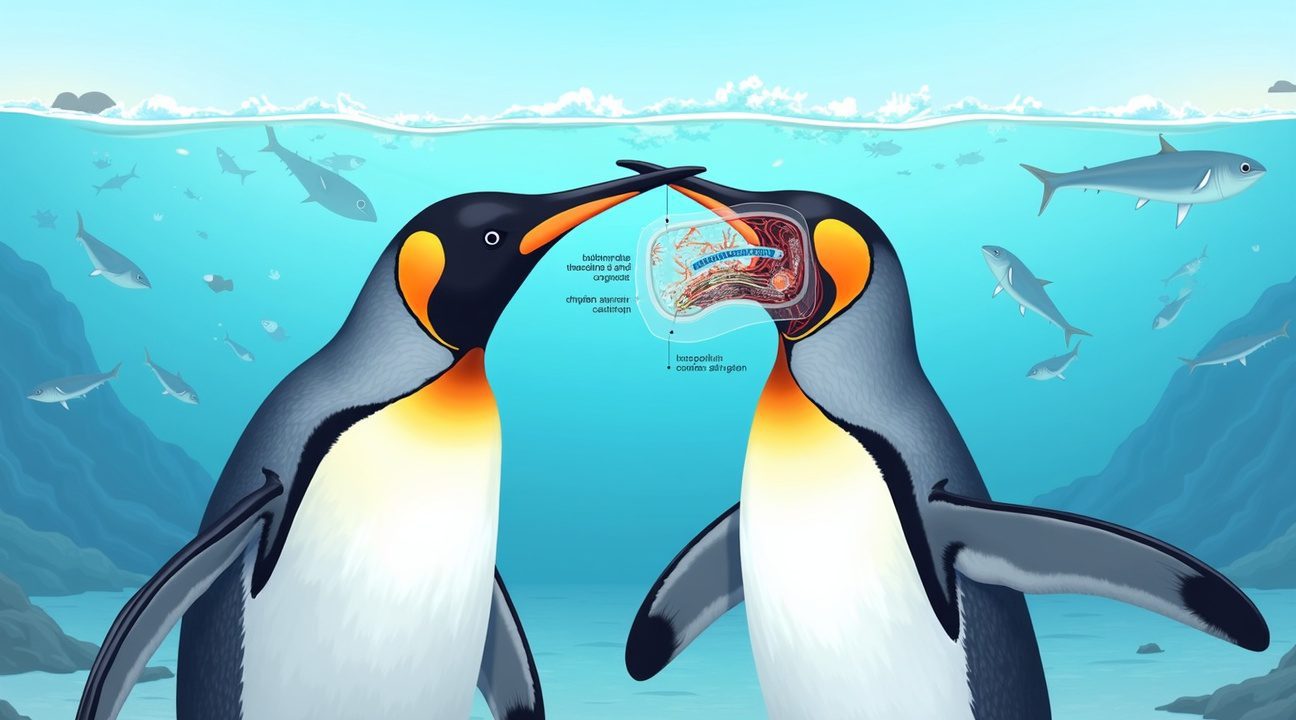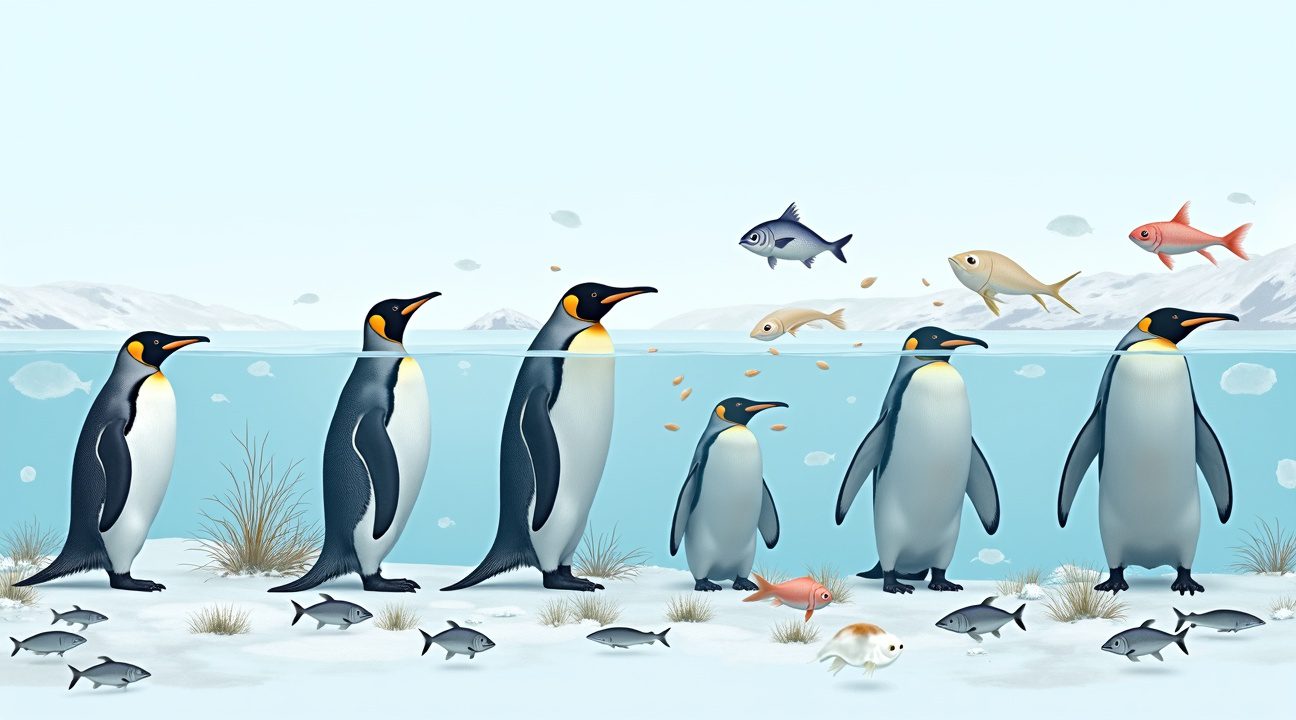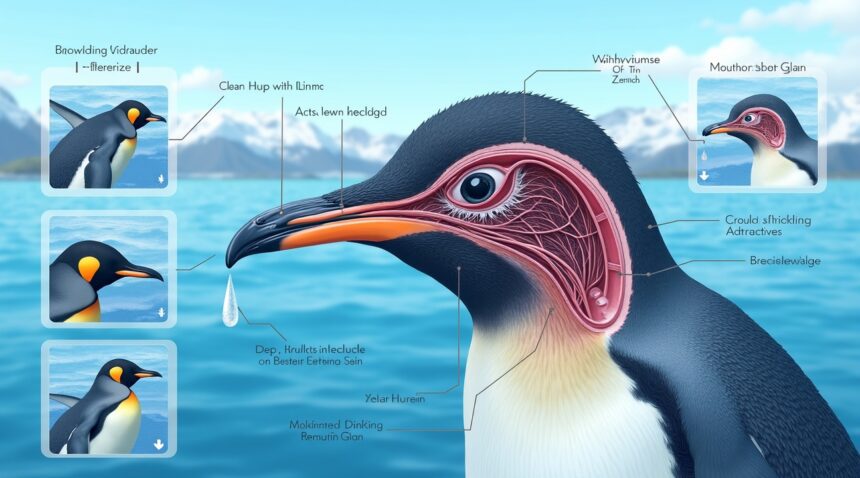Penguins have developed a remarkable biological adaptation that allows them to flourish in marine environments where freshwater is virtually nonexistent—specialized salt glands located above their eyes that efficiently filter sodium chloride from seawater.
Key Takeaways
- Penguins possess supraorbital salt glands positioned above their eye sockets that filter salt from seawater with remarkable efficiency, producing brine solutions five times saltier than normal body fluids.
- Different penguin species have varying salt gland sizes based on their diets—those eating marine invertebrates have larger glands due to higher salt content compared to fish-eating species.
- The salt filtering process involves dense capillary networks that extract sodium chloride from the bloodstream and channel concentrated brine through nasal passages for expulsion via the bill.
- Salt glands become dormant in captive penguins living in freshwater environments but can reactivate when reintroduced to saltwater, demonstrating remarkable physiological adaptability.
- This salt-filtering ability is shared among many seabird species including gulls, albatrosses, petrels, and puffins, representing a widespread evolutionary adaptation to marine life.
If you’d like to explore more about penguin adaptations, the National Geographic page on penguins offers fascinating and in-depth insights.
How Penguins Survive Drinking Ocean Water: The Secret Salt-Filtering Gland Above Their Eyes
Penguins possess a remarkable biological adaptation that allows them to drink seawater without suffering from dehydration or salt poisoning. This specialized mechanism centers around the supraorbital gland, commonly called a salt gland, positioned directly above their eye sockets. Scientists studying these fascinating creatures have discovered that this gland functions as a highly efficient salt-removal system, much like how scientists think they’ve discovered other biological mysteries.
The supraorbital gland operates similarly to a kidney but with one crucial difference – it’s specifically engineered for sodium chloride extraction. Dense networks of capillaries surround this gland, creating an intricate filtration system that continuously processes the penguin’s bloodstream. When penguins consume seawater either directly or through their salty prey, this specialized organ immediately begins working to separate the harmful salt from essential fluids.
The Filtration Process and Marine Survival
The efficiency of this salt excretion system proves absolutely vital for penguin survival in marine environments where freshwater remains virtually nonexistent. I find it remarkable how these birds have evolved such precise biological machinery to thrive in conditions that would quickly prove fatal to most other animals. The gland works continuously, processing large volumes of salt-laden fluids and expelling concentrated brine through the penguin’s nostrils.
This adaptation showcases the incredible evolutionary journey of seabirds, demonstrating how species develop specific solutions for environmental challenges. Marine birds face constant exposure to salt through their diet and habitat, making effective sodium chloride removal essential for maintaining proper cellular function. The supraorbital gland exemplifies nature’s ability to create specialized solutions, much like how other animals have developed unique survival mechanisms.
Penguins can consume substantial quantities of seawater without experiencing the negative effects that would overwhelm mammals or other bird species. Their salt glands process this excess sodium chloride so effectively that they maintain proper hydration levels while extracting necessary nutrients from their marine diet. This biological innovation allows penguins to spend extended periods at sea, diving for fish and krill without requiring access to freshwater sources that simply don’t exist in their Antarctic habitat.

The Life-Saving Process: From Salt Extraction to Brine Excretion
I find the salt extraction process in penguins absolutely fascinating. Once the supraorbital gland captures salt from the bloodstream, it transforms this extracted sodium chloride into a concentrated brine solution. This brine contains nearly five times the salt concentration found in regular penguin bodily fluids, making it an incredibly efficient filtration system that puts many human-made desalination processes to shame.
The Journey from Gland to Bill
The concentrated brine doesn’t simply sit in the gland—it needs an exit route. I observe that this salty solution flows through specialized channels into the penguin’s nasal passages, eventually making its way to the bill where it’s expelled from the body. Anyone watching penguins might notice what appears to be a constantly runny nose or frequent sneezing, but these aren’t signs of illness. These behaviors represent the active elimination of excess salt, keeping the penguin’s internal systems balanced and healthy.
Advanced Mechanics Behind Salt Removal
The internal mechanics of this process involve several sophisticated biological systems working in harmony. Capillary beds within the supraorbital gland create an extensive network for salt capture, while specialized canal systems direct the flow of concentrated brine. Scientists believe a counter flow principle may be at work here, maximizing the extraction efficiency by allowing blood and brine to flow in opposite directions, much like scientists think about other complex biological processes.
Salt expulsion becomes absolutely critical for penguin survival because excess sodium chloride creates a dangerous osmotic imbalance. When salt levels rise too high in bodily fluids, osmotic pressure draws water out of animal cells through osmosis. This water loss leads to cellular dehydration and potential cell damage, which could prove fatal in harsh Antarctic conditions. The supraorbital gland prevents this cellular crisis by continuously removing salt before it reaches dangerous concentrations.
By maintaining this constant cycle of salt extraction and brine excretion, the gland enables penguin cells to retain proper water levels and function normally despite living in a marine environment. This physiological adaptation represents a remarkable evolutionary advancement that allows seabirds like penguins to thrive where other animals would quickly perish from salt poisoning. The efficiency of this system demonstrates how nature develops solutions that often surpass human engineering capabilities.

Why Different Penguin Species Have Different Salt Gland Sizes
Salt gland dimensions across penguin species directly reflect their dietary preferences and feeding strategies. Penguins that rely heavily on marine invertebrates possess significantly larger and more active salt glands compared to their fish-eating relatives. This physiological difference stems from the stark contrast in sodium chloride content between these two primary food sources.
The Impact of Marine Invertebrates on Salt Processing
Marine invertebrates present a substantial challenge for penguin physiology due to their exceptionally high salt content. These organisms contain up to twice as much sodium chloride as teleost fish, creating an intense demand for enhanced filtration capabilities. When penguins consume krill, squid, and other invertebrates, their bodies must process massive amounts of salt that would otherwise prove toxic. This dietary pressure has driven the evolution of enlarged salt glands in species that specialize in invertebrate consumption.
Fish-eating penguin species face considerably less salt stress since teleost fish contain lower sodium chloride concentrations than the surrounding seawater. Their relatively smaller salt glands reflect this reduced filtration requirement, demonstrating how evolutionary pressures shape organ development based on environmental demands.
Ecological Adaptation Through Physiological Variation
The relationship between diet, habitat, and salt gland development illustrates a perfect example of ecological adaptation within the penguin family. Species inhabiting regions rich in marine invertebrates have developed enhanced salt processing capabilities, while those in fish-abundant areas maintain more modest filtration systems. This physiological flexibility allows different penguin species to exploit various marine niches effectively.
Feeding behavior patterns also influence salt gland activity levels throughout the year. During breeding seasons, when certain species increase their invertebrate consumption to meet higher energy demands, their salt glands work overtime to maintain proper electrolyte balance. Scientists have observed that researchers studying adaptation continue discovering new connections between dietary specialization and physiological modifications.
The variation in salt gland sizes represents a fascinating evolutionary response to dietary specialization. Each species has fine-tuned its salt processing capacity to match its preferred prey, creating a diverse range of filtration capabilities across the penguin family. This adaptation ensures optimal survival rates in their respective marine environments while maintaining the ability to thrive on their specialized diets.

When the Salt Gland Goes Dormant: Wild vs Captive Penguins
The supraorbital gland represents one of nature’s most adaptable filtration systems, responding directly to environmental demands. In wild penguins, constant exposure to seawater keeps this specialized organ working at peak efficiency, filtering salt continuously as these birds dive for fish and consume saltwater with their prey. The gland operates like a biological desalination plant, processing excess sodium chloride that would otherwise prove toxic to the penguin’s system.
Captive penguins tell a different story entirely. When housed in aquariums or zoos where freshwater replaces their natural marine environment, the supraorbital gland essentially shuts down operations. This dormancy occurs without any negative impact on the bird’s health, demonstrating remarkable physiological flexibility that scientists continue to study. The gland’s activity depends entirely on environmental triggers rather than genetic programming, much like how scientists think they’ve discovered other adaptive biological mechanisms.
The Efficiency of Active Salt Processing
When functioning at full capacity, the supraorbital gland produces a concentrated brine solution that’s approximately five times saltier than the penguin’s normal body fluids. This extraordinary concentration ratio showcases the gland’s remarkable efficiency in removing excess salt from the bloodstream. The concentrated solution drips from the penguin’s beak, effectively eliminating dangerous sodium levels that could disrupt cellular function and organ performance.
This process allows penguins to thrive in environments where other animals would quickly succumb to salt poisoning. Wild penguins can:
- Consume fish that contain seawater in their stomachs
- Drink seawater directly when thirsty
- Accidentally ingest saltwater while hunting underwater
Their specialized glands handle these challenges effortlessly, maintaining proper electrolyte balance despite constant salt exposure.
The transition between active and dormant states happens gradually over weeks or months as captive penguins adjust to their new environment. Zoo veterinarians monitor this transition carefully, ensuring that other physiological systems compensate appropriately for the reduced salt processing capacity. Interestingly, captive penguins can reactivate their salt glands if reintroduced to saltwater environments, though this process takes time and careful monitoring.
Researchers have found that the gland’s dormancy in captivity actually conserves energy that wild penguins must expend on constant salt filtration. This energy conservation may contribute to longer lifespans observed in some captive penguin populations, though other factors like predator absence and consistent food supply also play significant roles. The adaptability mirrors other biological mysteries that continue to fascinate researchers, similar to how robots amazingly escape from constraints through unexpected mechanisms.
Understanding this dormancy pattern has practical implications for penguin care in captivity. Aquarium staff can:
- Adjust water salinity levels gradually to aid new arrivals
- Use controlled exposure to seawater in rehabilitation
- Prepare penguins for a return to the wild
This knowledge proves crucial for breeding programs and conservation efforts that aim to maintain healthy penguin populations both in captivity and in their natural habitats.
The supraorbital gland’s ability to switch between active and dormant states represents evolutionary adaptation at its finest. This flexibility allows penguins to survive in diverse environments while maintaining optimal health, whether they’re diving in Antarctic waters or living in carefully controlled aquarium settings.
Penguins Share This Superpower with Many Other Seabirds
Penguins aren’t the only birds equipped with this remarkable salt-filtering ability. Supraorbital salt glands represent a widespread adaptation that numerous seabird species have developed to thrive in marine environments. These specialized organs allow birds to extract fresh water from their salty surroundings, creating an evolutionary advantage that spans across multiple bird families.
Marine Birds with Salt-Filtering Capabilities
Many familiar seabird species possess these highly effective salt glands that enable them to drink seawater safely. The following birds share this adaptation with penguins:
- Gulls and terns utilize their salt glands while foraging along coastlines and open ocean
- Petrels and albatrosses rely on these organs during extended oceanic journeys
- Loons access both freshwater and saltwater habitats thanks to their filtering systems
- Puffins and other auks depend on salt glands while diving for fish in saline waters
- Pelicans filter salt efficiently while hunting in coastal and marine environments
- Sea ducks and geese maintain hydration across varied aquatic habitats
Evolutionary Significance of Salt Glands
All bird species technically possess salt glands, but marine birds have developed enlarged and highly efficient versions of these organs. This adaptation reflects broader evolutionary processes that occurred as certain bird lineages specialized for life in salty environments. Scientists have observed that these glands can become more active and enlarged based on the bird’s exposure to saltwater, demonstrating remarkable physiological flexibility.
The presence of effective salt glands across diverse seabird families highlights how similar environmental pressures led to comparable evolutionary solutions. Just as scientists think they’ve discovered patterns in human brain function, researchers have identified consistent adaptations across marine bird species. These organs work so efficiently that seabirds can maintain proper hydration even when consuming prey with high salt content or drinking directly from the ocean.
Marine birds demonstrate how evolution creates practical solutions for survival challenges. Their salt glands function as biological desalination systems, concentrating excess sodium and chloride ions before expelling them through specialized ducts. This shared adaptation among penguins, albatrosses, gulls, and other seabirds represents one of nature’s most elegant examples of convergent evolution in action.
Sources:
Wikipedia, “Salt gland”
Smithsonian National Museum of Natural History, Hauserman Poster: “The Relationship Between Salt Gland Depression Size and Body Size”
YouTube, “An Amazing Adaptation: the Supraorbital Gland”
PinguinWissen: “Salt glands”
Travis Audubon, “Salt Glands in Seabirds”


